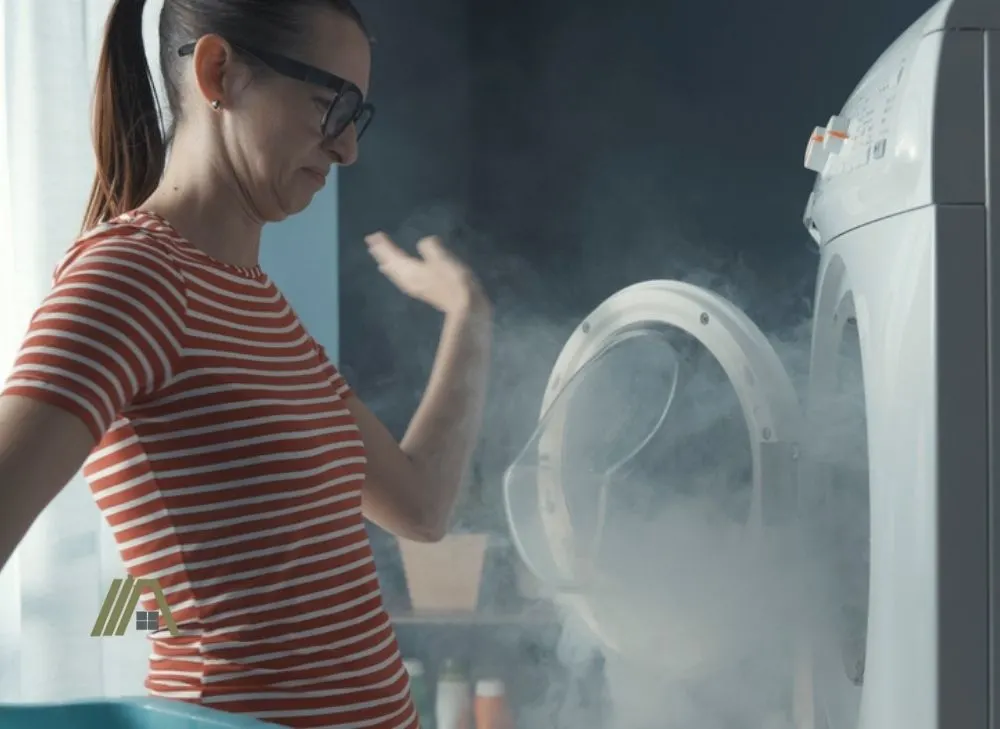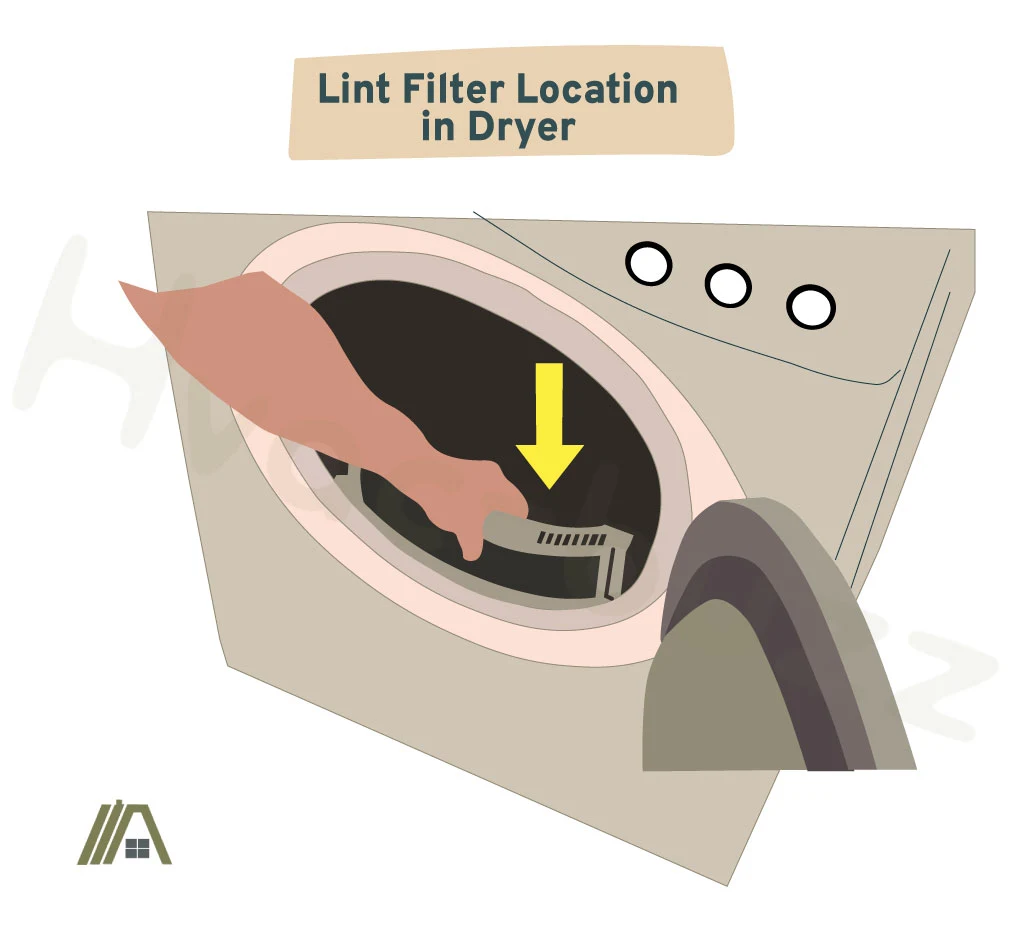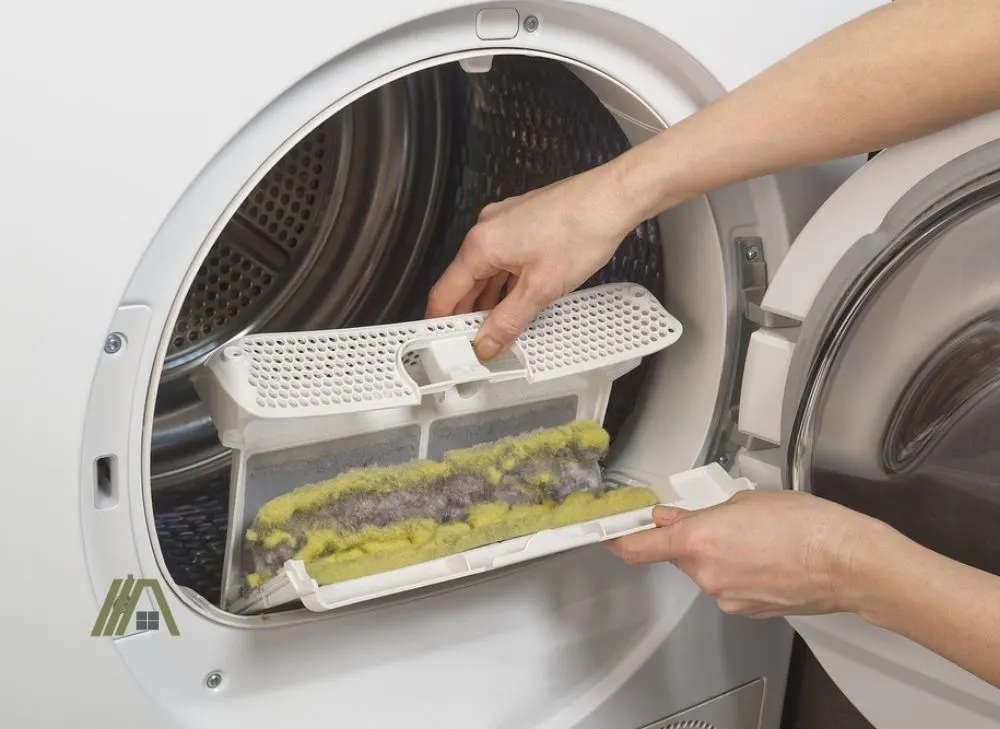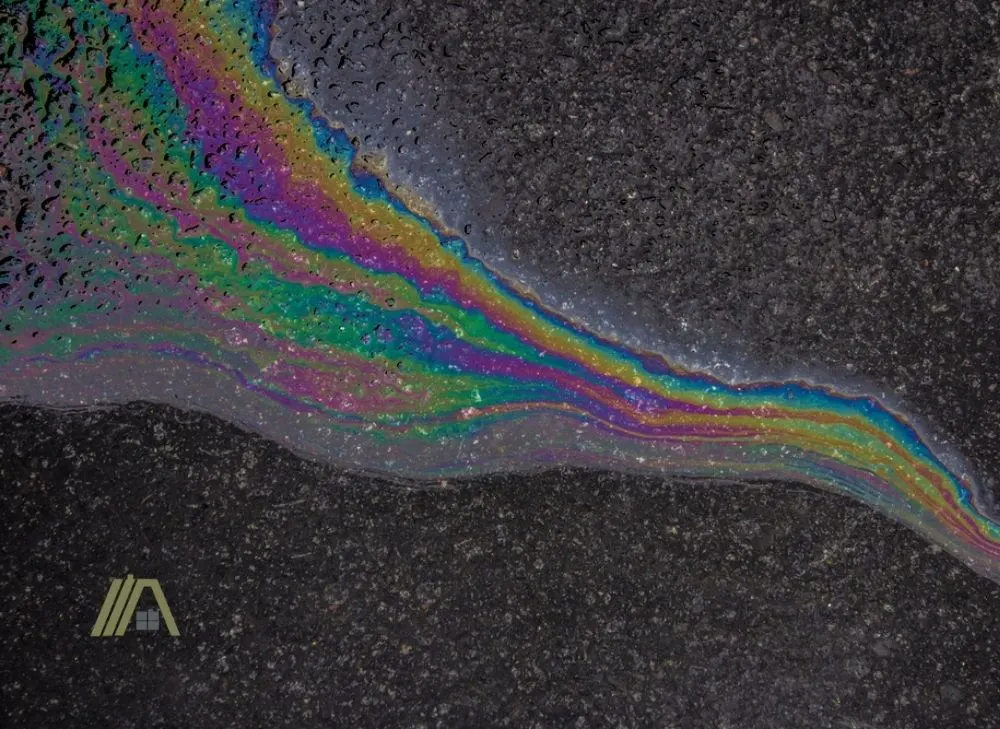Is there anything more annoying than taking out freshly washed and dried clothing from your dryer only to find black and brown stains when folding them? If they are salvageable, they will at the very least require re-washing and re-drying.
There are several causes of black or brown stains on clothes coming out of the dryer and, happily, a solution to each one of them!

Clothing can have brown/black stains after tumble drying if the drum felt seal, drum glides, or rollers are worn. Clogged vents, dirty or cracked lint screens, and overheating drums can also stain clothes. Clothes can be marked by items that shouldn’t be in the dryer and oil leaks.
Worn Drum Felt Seal
A drum felt seal is found on the front and back edge of the dryer drum. This seal helps to separate the drum and the panels of the dryer, limiting the airflow and ensuring that the drum remains sealed and safe for your clothes.
If the drum felt seal begins to deteriorate, your clothes can get stuck in between the drum and the panels. If stuck, your clothes can then become stained or even torn and they are subjected to dirt in the dryer housing as well excessive heat or friction.
This is often accompanied by scraping and thumping sounds and your clothes taking a much longer time to become dry.
The deteriorating seal and glue can also stain your clothing when this is the problem.
Solution
The only real solution for when your dryer felt seal is worn is to replace it.
For most dryers, replacement is relatively easy. It involves removing the front loading door (this will not be a problem with top loaders) and accessing the drum.
You then remove the old felt seal, clean away any debris, and fix the new dryer felt seal (amazon link) into place.
Look at your dryer manual for more information, but videos such as the one presented below can be extremely beneficial to your DIY felt seal replacement. You should be able to find videos for most of the major dryer brands in the USA.
Clogged Dryer Vent
A clogged dryer vent can lead to your dryer overheating, burning your clothes, and possibly even causing fires.
Lint and dust can get trapped within the dryer vent leading to the vent clogging up if it is not cleaned out regularly.
A clogged vent is often accompanied by a burning smell because it interferes with the airflow in a dryer. Your dryer will not be able to expel air correctly, and it will get too hot and ultimately scorch your clothes.
Tell-tale signs of a possible clogged vent, other than scorched clothing, are a burning smell or your dryer feeling very hot to the touch.
You need to be careful when this occurs as increased internal temperatures coupled with large quantities of trapped lint substantially increase the risk of fire.
Clogged vents also often result in leaking dryer vents.
Solution
To prevent clogged vents, it is important to clean them out regularly.
Using a dryer brush kit (amazon link), you can easily clean out the lint and dust from your vent to avoid your vent becoming clogged and overheating.
Regular dryer services are also necessary to ensure that a clogged vent does not occur.
Dryer is Overheating
Your dryer overheating is perhaps one of the most common reasons for black or brown scorch marks on your clothing.

As mentioned in the previous section, an overheating dryer can also cause fires and it is, therefore, incredibly important that you investigate the reason for your dryer overheating and repair what is necessary to restrict danger.
In this way, scorched clothes, while inconvenient, are a good indication that you need to address your dryer’s condition as soon as possible.
We have already looked at how a clogged dryer vent can stain your clothes, but this is not the only reason why dryers overheat.
Dryers can overheat due to a damaged blower wheel. The blower wheel draws air over the heating element/flame and pushes it into the dryer drum. The wheel works with the motor to move the air around the drum to help dry the clothes, and then gets rid of this air through the exhaust vent.
If this blower wheel is damaged, the air will not circulate or disperse effectively and can cause your dryer to overheat.
Another common cause of overheating is when a cycling thermostat is not working. A dryer’s cycling thermostat helps regulate its temperature, keeping it from overheating or delivering too little warmth to dry your clothes.
Obviously, if it malfunctions in a way that means the temperatures get too high, your clothes can burn, causing black/brown stains.
Overheating can also occur when the heating element is damaged and remains switched on. The heating element is what heats the air inside your dryer. Heating elements will often become faulty if they are blocked, leading to a build-up of hot air. This trapped hot air can then lead to overheating.
Overloading your tumble dryer can also cause scorch marks on your clothing. The items are not able to move around easily, resulting in uneven exposure to heat.
Some clothes will still be wet when the cycle is over because they were never exposed to the hot air. Others will be burnt because they were overexposed.
Solution
Make sure that you are not overloading your dryer. You can check the weight capacity in the user manual. My dryer has a mark on the front panel that says where clothes can be loaded up to.
Clean out any lint. Remove the lint trap and vacuum out all the lint. You can then use some soapy water and a toothbrush to clean up any residue. Make sure your lint trap is completely dry before you replace it to avoid mold or rust from forming.
If you use dryer sheets, lint can accumulate within your dryer blower wheel. Often clumps of lint can get stuck in between the groves of the dryer blower wheel. Cleaning out this lint can be much cheaper than having to replace your blower wheel. All you need to do is:
- Remove the exhaust hose and the metal plate that covers that same area.
- Remove the drum from the dryer and the motor to access the blower wheel.
- Remove the lint and finally reassemble your dryer.
If lint is not your issue, you will have to assess the function of your cycling thermostat and heating element. These may need to be replaced.
Cracked or Dusty Lint Screen

In most dryers, the lint screen is located in the door opening of the dryer. Lint screens help to catch the lint produced by your clothing as it dries and should be cleaned after every use to avoid a build-up.
If your lint screen is dusty or cracked, not only will it make your drying time increase, but it can also leave stains on your clothes.
- If you wash your lint screen and put it back into the dryer before it is completely dry, it could cause rust, which in turn stains your clothes.
- If the screen is cracked, your clothes could catch on it, with the result being dirt marks or even scorch marks.
Solution
The best thing to do to avoid a cracked or dusty lint screen is to ensure you clean out all the lint and dust from your dryer screen after every use.
Remove the lint screen from the dryer, remove the lint and use a vacuum to suck up any additional dust and debris.
When you clean it out regularly, you will easily spot any cracks, allowing you to replace it before these cracks can snag your clothes.
A cracked lint screen is an easy replacement with many affordable options (amazon link) available.

Drum Glides are Worn
Drum glides support the front of the dryer’s drum on either side and allow the drum to rotate smoothly. If your clothes become stained and you notice a scraping metal-on-metal noise, your drum glides could be to blame.
Because your dryer glides can become worn down, clothes can become stuck in between the glides and the metal drum leaving stains (spots like this can be oiled to prevent excessive friction) or even tearing your clothes.
Solution
Drum glides have an average life span of around 5 years, depending on the frequency that you use your dryer. It is, therefore, inevitable that your drum glides will need to be replaced.
In order to replace your glides correctly, you will first need to determine which ones are being used, or more specifically, how they are attached:
- Some drum glides are attached with very strong glue, and replacement will require using a putty knife to help remove all the old glue, before applying the new glue and the new drum glides.
- If the glides are plastic or Teflon, you will often need to remove bolts to replace them.
It is important to consult your user manual to find out which drum glides you require and how best to replace them.
Things That Don’t Belong in the Dryer
Sometimes stains on your clothing can be the result of human error, like when we do not realize that we have put something in the dryer that does not belong there.
It could be a forgotten item in your pocket that has melted and stained your clothes. Think sweets, gum, or even chocolate wrappers.
Or perhaps it’s keys or coins that fall out of the pocket and end up clogging your dryer motor or vent leading to a build-up of lint or dirt.
Rubber items like bathroom mats or sneakers can sometimes melt, leaving waxy stains on your clothing or inside your dryer. This means that the next load put inside gets dirty as well.
Oily stains on your clothing may not have been completely cleaned after washing and it remains unnoticed before putting the stained clothes in the dryer. These stains can become worse and more difficult to remove when heat is added.
The oil can also transfer to the dryer surface. Oil build-up in your dryer may not only lead to stained clothes but can also be a fire hazard.
Drying your mattress protector at a high temperature can cause the waterproofing to come off and cling to other clothing in the dryer.
Solution
To avoid stains, make sure to remove any foreign items from your clothing before placing them in the dryer.
Check that your clothing is clean after washing to ensure that the issue does not exist before your clothes are put in the dryer.
If your dryer has melted wax or oil inside the drum, using a solution of equal parts white vinegar and warm water in a spray bottle can do the trick.
Spray the solution over the stain and, with a damp cloth, scrub off the excess dirt. Then take a clean cloth to dry the drum afterward. This should help remove any of the dirt that could stain your clothes.
Oil Leaking Into the Drum
If oil is not from an item of your clothing, the oil may be leaking into your drum from your dryer rollers or your dryer motor.

If you have dryer rollers that are lubricated, the oil can enter the drum, staining your clothes or attracting more dirt and lint, which not only dirty clothes but also create ideal conditions for fire ignition.
Unless the manufacturer instructions expressly say that lubricating your dryer rollers is necessary, it is best not to interfere.
Another culprit of oil in the drum may be your dryer’s motor. The dryer’s motor uses oil to run. If it fails, it could leak oil, which could stain your clothes.
You may be able to notice that your motor is leaking oil if you see that it is taking longer for your clothes to dry, the tumbling action could seem to be stunted or slow, and it could produce strange noises.
Solution
If oil is present in your dryer, first locate the source.
Should the source be the dryer rollers, then cleaning all the lubricant off is perhaps the simplest answer.
However, until all the lubricant is off of the rollers, your problem may continue. Replacing your rollers is a fairly simple process and new rollers (amazon link) are relatively affordable.
If your dryer’s motor is leaking oil, your best bet would be to contact a repairman as the motor is integral in the running of your dryer.
Drum Rollers Have Failed
Most dryers will have two or more rollers supporting the back of the drum, and some models will have another two rollers supporting the front of the drum.
If these rollers or the axles that hold these rollers wear out, the drum will have difficulty spinning and ultimately drying your clothes.
If the drum rollers fail, and the drum cannot turn, your clothing can become caught and then stain.
Failed or worn rollers will often be accompanied by squealing or thumping noise.
Solution
If your drum rollers have failed or have become worn, replacing them is necessary. Drum roller replacement kits (amazon link) are readily available and easy to install. Just make sure you consult your appliance manual.
